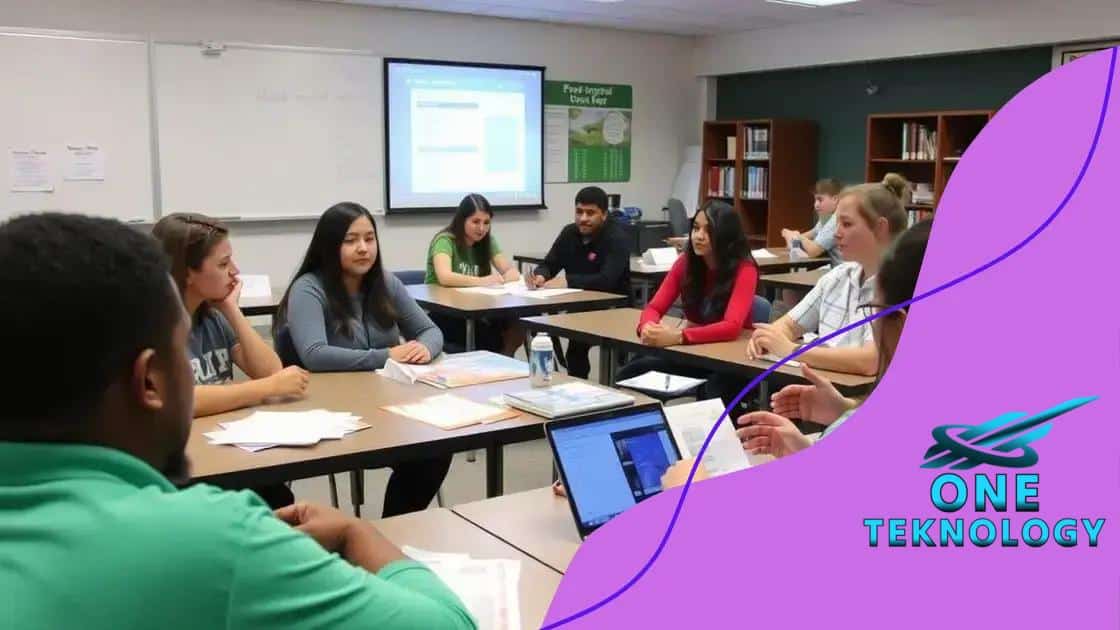Integrating financial literacy into school curricula: why it matters

Integrating financial literacy into school curricula equips students with essential skills to manage money, make informed financial decisions, and prepare for future economic challenges.
Integrating financial literacy into school curricula can transform students’ understanding of money management. Have you thought about how vital this knowledge is for their adult lives? Let’s dive into why it matters.
Understanding financial literacy
Understanding financial literacy is essential for navigating today’s complex financial landscape. It empowers individuals to make informed decisions about saving, spending, and investing their money wisely.
Financial literacy encompasses various concepts that are crucial for everyone, especially students. When students learn about finance early on, they develop a foundation that will serve them throughout their lives.
Key Concepts of Financial Literacy
At its core, financial literacy involves understanding key concepts such as:
- Budgeting: Knowing how to create and stick to a budget helps manage personal finances effectively.
- Saving: Understanding the importance of saving for both short-term and long-term goals is vital.
- Investing: Introducing the basics of investing can help students grow their wealth over time.
- Debt Management: Learning how to manage and pay off debt responsibly is crucial for financial health.
By incorporating these concepts into school curricula, we equip students with the skills to handle their finances. This understanding promotes smart choices that can lead to positive financial outcomes.
Another important aspect is the practical application of financial literacy. Teaching students to manage real-life scenarios enhances their learning experience. For instance, using simulations or real-life case studies can make these concepts tangible and relatable.
Financial literacy also involves awareness of the broader economic environment. Students must understand how economic conditions affect their personal finances. This awareness can be beneficial as they plan for their future.
Why Financial Literacy Matters
In today’s society, being financially literate is not just beneficial but essential. It can lead to better job prospects and the ability to make sound financial choices. Graduates who possess strong financial skills are often more prepared for life post-school.
Additionally, teaching financial literacy can help reduce poverty and empower communities. Finances impact our quality of life, and education can play a significant role in promoting fiscal responsibility.
Incorporating financial literacy into school curricula creates informed citizens who can contribute effectively to the economy. As schools prioritize financial education, students become equipped to navigate their financial futures confidently.
The role of schools in teaching finance
The role of schools in teaching finance is crucial for students’ development. Schools not only provide academic knowledge but also shape real-world skills. By incorporating financial education into their curricula, schools prepare students for financial independence.
Every school has the opportunity to make a significant impact on how students perceive money management. From an early age, introducing financial literacy can help students develop smart saving and spending habits.
Why Financial Education is Important
Understanding finance is vital in today’s economy. Financial education in schools empowers students by teaching them:
- Basic Money Management: Students learn the importance of budgeting and how to track their expenses.
- Impact of Credit: Understanding how credit works helps them make informed choices about borrowing.
- Personal Savings: Learning to save early can set students on track for financial success.
- Investment Basics: Familiarity with investing concepts can help students grow their wealth over time.
Schools can utilize various methods to teach finance effectively. For instance, interactive workshops and real-world simulations can engage students in financial discussions. These practical experiences help students relate the concepts to their own lives.
Furthermore, involving parents in financial education can bridge the gap between school learning and home practices. Schools can provide resources for parents to discuss financial topics at home. This collaboration reinforces the concepts learned in class.
Integrating Finance into the Curriculum
To successfully integrate finance into the curriculum, schools can start by aligning financial topics with relevant subjects. For example, math classes can include practical applications of percentages and ratios in budgeting. Social studies can explore the economic impact of financial decisions.
Teachers play a vital role in making financial education engaging. By using real-life examples, educators can ignite students’ interest in finance. Incorporating technology, such as budgeting apps or online simulations, can also enhance the learning experience.
Ultimately, schools need to recognize their influential position in shaping financially savvy students. By prioritizing financial literacy, schools contribute to creating a generation capable of making informed financial decisions.
Key topics to include in curricula

When it comes to financial literacy education, schools should consider including a variety of key topics in their curricula. These topics ensure that students receive a well-rounded understanding of personal finance, equipping them for a successful future.
Some critical areas of focus include:
Essential Components of Financial Literacy
- Budgeting Skills: Teaching students how to create and manage a budget is fundamental. They will learn to track their income and expenses, ensuring they live within their means.
- Saving and Emergency Funds: Students should understand the importance of saving money regularly. Establishing an emergency fund can help them handle unexpected expenses.
- Debt Management: Understanding how to manage debt responsibly is crucial. Lessons on credit cards, loans, and interest rates prepare students for the challenges of borrowing.
- Investing Basics: Introducing the principles of investing can empower students to make informed choices about growing their wealth through various investment opportunities.
In addition to these topics, schools should explore the impact of consumer behavior on financial decisions. Teaching students about advertising, marketing, and the psychology of spending can help them make smarter choices as consumers.
Moreover, discussing different financial products such as bank accounts, insurance, and retirement plans opens up avenues for students to understand their options. This knowledge can help them make wise financial decisions in adulthood.
Real-World Applications
Incorporating real-world scenarios and practical applications into lessons can enhance the learning experience. For example, using role-playing exercises to simulate real-life financial decisions encourages critical thinking.
Furthermore, bringing in guest speakers from various financial fields allows students to gain insights from professionals. These experiences can enrich the curriculum and provide valuable context for the topics discussed.
By including these key topics in financial literacy curricula, schools can help students build a strong foundation for their financial futures. This education empowers them to navigate the complexities of today’s financial world with confidence.
Benefits of financial literacy for students
The benefits of financial literacy for students are extensive and impactful. Understanding how to manage money can significantly influence a student’s future choices and habits. With a solid foundation in financial concepts, students become more confident in handling their personal finances.
One major benefit is the enhancement of decision-making skills. When students learn about budgeting, saving, and investing, they are more likely to make informed decisions regarding their money. This knowledge helps them avoid common pitfalls like overspending or accumulating unnecessary debt.
Key Advantages of Financial Literacy
- Improved Financial Decision-Making: Students equipped with financial literacy are better at evaluating financial options and understanding the consequences of their choices.
- Preparation for Future Responsibilities: As students transition into adulthood, having financial knowledge prepares them for responsibilities like paying bills, managing expenses, and saving for retirement.
- Reduced Anxiety Around Finances: Familiarity with financial concepts helps students feel less intimidated by financial discussions or situations, leading to a more relaxed approach to managing money.
- Empowerment in Life Choices: Financial literacy empowers students to make choices that align with their values and goals, whether that’s pursuing higher education, buying a home, or starting a business.
Moreover, learning financial literacy promotes essential life skills. Students develop discipline through budgeting and saving practices. They learn to set financial goals and work towards achieving them. This skill set not only enhances their personal lives but also prepares them for future challenges.
Additionally, financial literacy can positively impact students’ academic performance. When students are less stressed about their finances, they can focus better on their studies. The ability to manage money responsibly contributes to a more balanced and fulfilling student experience.
Long-Term Impacts
The long-term benefits of financial literacy stretch beyond school. Students who start learning about finances early often become more successful adults. They are likelier to build wealth, invest wisely, and secure their financial futures.
Incorporating financial education in schools can lead to healthier economic outcomes for entire communities. As financially literate individuals contribute to the economy, they help foster growth and stability.
Future implications of financial literacy education
Future implications of financial literacy education are vast and critical in shaping how upcoming generations handle their finances. As financial landscapes evolve, the need for informed individuals capable of navigating complex financial choices becomes essential.
By integrating financial literacy into education today, we are preparing students for a future where they can confidently tackle financial challenges. This preparation is vital in a world filled with credit cards, loans, and investment opportunities.
Long-Term Benefits
- Informed Decision-Making: Students who receive financial education are better equipped to make wise financial decisions throughout their lives.
- Reduced Financial Stress: Knowledge about managing finances can alleviate anxiety, allowing individuals to focus on their personal and professional goals.
- Wealth Creation: Financial literacy can lead to building wealth over time. Understanding investments and savings can result in a more secure financial future.
- Community Growth: As financially literate individuals contribute to their communities, they promote economic growth and stability.
Moreover, preparing students with financial skills fosters a cycle of empowerment. Students who master financial concepts will likely pass this knowledge to their peers and future generations. This knowledge-sharing can create a ripple effect, enhancing overall community financial health.
With technology and finance continually changing, ongoing financial education will become even more crucial. Schools will need to adapt their curricula to include topics such as digital currencies and online banking. This adaptation will ensure that students are not only prepared for today’s world but also for future innovations.
Career Opportunities
Financial literacy opens up a wide range of career opportunities. Students who understand finance may pursue careers in banking, investment, economics, or financial planning. These fields often require strong financial skills, making early education a stepping stone for future success.
Ultimately, prioritizing financial literacy education leads to a brighter future for students. As they enter adulthood with the knowledge they gain, they will be more capable of making sound financial choices that benefit not just themselves but also their communities.
In conclusion, integrating financial literacy into school curricula is essential for equipping students with the necessary skills for their future. By learning about money management, students can make informed decisions, reduce financial stress, and empower themselves to pursue their goals. The long-term benefits of financial education contribute not only to individual prosperity but also to community development. As we prepare the next generation for a complex financial landscape, we pave the way for a more economically stable and informed society.
FAQ – Frequently Asked Questions about Financial Literacy Education
Why is financial literacy important for students?
Financial literacy is important because it teaches students how to manage money, make informed decisions, and prepare for future financial responsibilities.
What are the key topics included in financial literacy education?
Key topics include budgeting, saving, debt management, investing basics, and understanding financial products and services.
How does financial literacy benefit the community?
Financially literate individuals contribute to economic stability and growth, as they are better equipped to make responsible financial decisions.
What role do schools play in teaching financial literacy?
Schools play a vital role by incorporating financial education into the curriculum, ensuring that students gain essential knowledge and skills for their financial futures.






